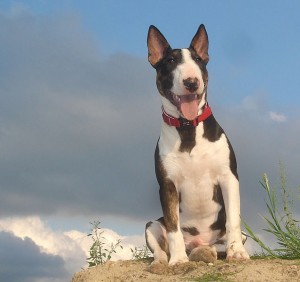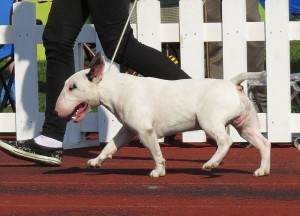 The ‘bull and terrier’ type was originally developed in England in the early 19th century. The lineage goes back to the mastiff / molosser types, including what we now call the Old English Bulldog, that were used for bear-, bull- and horse-baiting from the 12th through the 18th century. This isn’t the bear-baiting we think of today, when hunters feed bears in order to bring them out in the open to shoot them. Rather, the bear, bull or horse was confined in a public arena where the mastiff ‘bulldogs’ would slowly tear them apart alive for the public’s amusement1,2,3,4,5. The popularity of this ‘sport’ declined as education became more emphasized in urban society of the Industrial Revolution and literacy among the population grew (from about 30% in the 17th century to 62% by 1800)6. The ‘sport’ was banned altogether by Act of Parliament in 1835.
The ‘bull and terrier’ type was originally developed in England in the early 19th century. The lineage goes back to the mastiff / molosser types, including what we now call the Old English Bulldog, that were used for bear-, bull- and horse-baiting from the 12th through the 18th century. This isn’t the bear-baiting we think of today, when hunters feed bears in order to bring them out in the open to shoot them. Rather, the bear, bull or horse was confined in a public arena where the mastiff ‘bulldogs’ would slowly tear them apart alive for the public’s amusement1,2,3,4,5. The popularity of this ‘sport’ declined as education became more emphasized in urban society of the Industrial Revolution and literacy among the population grew (from about 30% in the 17th century to 62% by 1800)6. The ‘sport’ was banned altogether by Act of Parliament in 1835.
The lovers of blood ‘sports’ turned to dogfighting to satisfy their fancy, breeding the large, mastiff-type bulldogs to smaller working terriers to get dogs both smaller and more agile, easier to keep and to hide, but just as willing to fight to the death. With the rise of the kennel clubs and the desire to distinguish dogs by looks and pedigree as well as by performance, this ‘bull and terrier’ type eventually divided into many official breeds. They all share the same ancestry and function, distinguishing themselves mostly by slight differences in look.
The English Bull Terrier (in Europe still officialy simply the ‘Bull Terrier’) distinguishes itself by its egg-shaped head and gladiator body. Tiny amounts of other breeds were mixed in to get the distinguishing head shape, as well as to produce exotic colors such as all-white and brindle. The English Bull Terrier is an energetic dog, playful with its owners, and active. It is affectionate towards its owners, needs their company, and can’t be kept outdoors in a kennel or left alone for eight hours a day. The English Bull Terrier needs frequent, brisk walks, occasional vigorous games, and total immersion in the family. If ignored, the dog can become bored, and resort to devouring your furniture, wrecking your yard, spinning in circles, and tail chasing7.

The English Bull Terrier is an independent, strong-willed, and can be stubborn. They can be difficult to train. Training sessions should be brief and food used as motivation. With the right type of owners this dog can be a joy to own, but it is not recommended for most households. They are too energetic for small children, often unable to calm themselves once they become excited and boisterous. They may try to join in family roughhousing or quarrels, which can lead to problems with smaller children since they have been bred to ‘finish a fight’ once it starts. They should be socialized to having visitors in the home from a young age and taught that all humans mean good news. These Bullies usually greet strangers with enthusiastic bounding, jumping, and face-kissing, often knocking the guest over. Some lines are aggressive or timid with strangers. The English Bull Terrier is prone to developing food aggression. Never allow a child to approach the dog when it is eating8. At some point, they often challenge their owner’s ability to control their actions. The response should be calm but firm.
The English Bull Terrier can be extremely aggressive with other dogs, so they do not belong at the local dog park. They should not be kept with any dog of the same sex. They are not recommended with other pets, such as cats, rabbits, hamsters, or horses.
The Miniature Bull Terrier is identical to the English Bull Terrier is everything but size.
The English Bull Terrier is 20 – 24 inches at the shoulders, weighing 45 – 80 pounds. The miniature version is 10 – 12 inches high, weighing 24 – 33 pounds. Their short coats require little care, and they are average shedders. They are not suited for very cold climates. The English Bull Terrier is prone to a range of hereditary problems, including dislocation of knee caps, kidney failure, skin and flea allergies, fatal zinc deficiency, acral lick dermatitis, heart problems, fragile skin, entropion, hermangiosarcoma, early arthritis9. Congenital behavioral abnormalities in the English Bull Terrier include a whole range of abnormal behavior patterns, such as aggression, panic disorders, rage syndrome, obsessive compulsive disorders like “spinners” or tail chasing, and pica10. They gain weight easily. Their life expectancy is 10 – 12 years if they do not turn up with one of the many life-shortening congenital health problems.
1. http://www.coeffic.demon.co.uk/bearbaiting.htm
2. http://www.elizabethan-era.org.uk/elizabethan-bear-bull-baiting.htm
3. Lee, Sir Sidney. “Bearbaiting, Bullbaiting, and Cockfighting.” Shakespeare’s England: An Account of the Life and Manners of his Age. Vol II. Oxford: Clarendon Press, 1916.
4. Scott-Warren, Jason. “When Theaters Were Bear-Gardens; or, What’s at Stake in the Comedy of Humors.” Shakespeare Quarterly. Vol. 54, No. 1, Spring 2003. 63-82.
5. Encyclopaedia Britannica 3. Encyclopaedia Britannica Company. 1910. p. 575
6. Johnathon Barry, ‘Literacy and Literature in Popular Culture: Reading and Writing in Historical Perspective,’ in Popular Culture in England, c. 1500-1850, ed. by Tim Harris (London, 1995), pp. 69-94 (p. 70)
7. http://www.yourpurebredpuppy.com/reviews/bullterriers.html , passim, (accessed February 2014)
8. Ibidum
9. http://www.hsvma.org/assets/pdfs/guide-to-congenital-and-heritable-disorders.pdf (accessed February 2014)
10. Ibidum
